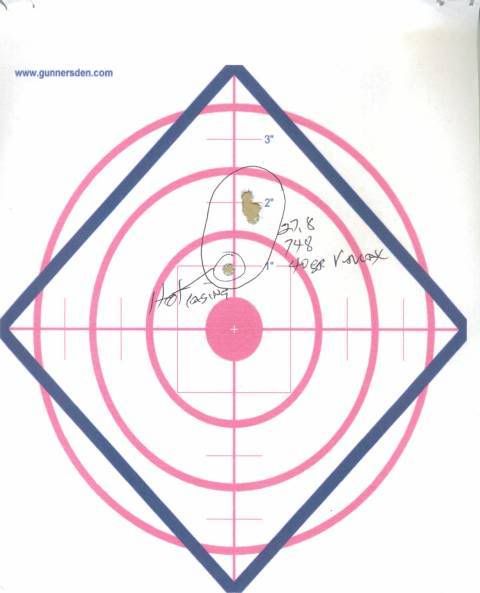I started to develop a load for my Stevens in 223, using 60 vmax, varget, 205M primers,winchester brass trimmed to 1.75" full length sized. I thought it would be easier to find the best load from the ones I tried, but my results are not that definate. I tried 25, 25.5, 26, 26.5, 27, 27.2grs. 3 shot groups, and recorded velocities 12" from the muzzle. The best group was the 26gr. .553", avg. velocity of 3079 33.62ES, 17.6 SD. But the 26.5, 27 and 27.2 all had lower ES and SD, with the 27.2 having 7.58 ES and 4.12 SD, avg. of 3193 FPS, the first two shots being 1.155", and the third falling in between the first two.
The 26.5 load had the first two shots touching, the third off to the left for a 1.136" group, avg. 3126, 12.94 ES, 7.21 SD.
27 load first two shots almost touching, third off to the left and high, .734" group, avg 3176, 21.64 ES, 11.35 SD.
It was a bit windy, and I could have pulled the left shots on the 26.5, 27, and 27.2 groups. The other strange thing is the the 26 and 26.5 groups had the same point of inpact, but the 27 and 27.2 moved another inch higher and 1/2" to the left.
Should a person try the load with the lowest ES and SD again, or is it possible that the 26 grain load will group the best even though it has the greatest ES and SD? Should I load 5 rounds of each and try for groups again? I'd post pics, but am unsure how to do so.
Thanks
The 26.5 load had the first two shots touching, the third off to the left for a 1.136" group, avg. 3126, 12.94 ES, 7.21 SD.
27 load first two shots almost touching, third off to the left and high, .734" group, avg 3176, 21.64 ES, 11.35 SD.
It was a bit windy, and I could have pulled the left shots on the 26.5, 27, and 27.2 groups. The other strange thing is the the 26 and 26.5 groups had the same point of inpact, but the 27 and 27.2 moved another inch higher and 1/2" to the left.
Should a person try the load with the lowest ES and SD again, or is it possible that the 26 grain load will group the best even though it has the greatest ES and SD? Should I load 5 rounds of each and try for groups again? I'd post pics, but am unsure how to do so.
Thanks



